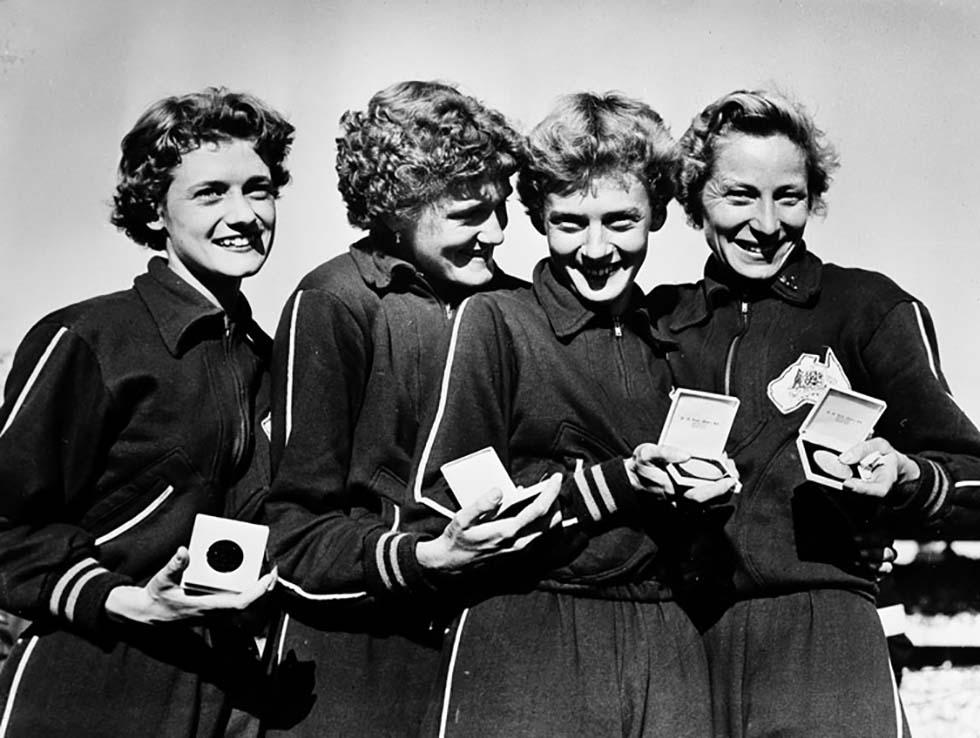


About this record
This black-and-white photograph shows the victorious Australian women's 4 x 100 metres track relay team holding their boxed gold medals after the medal ceremony at the Melbourne Olympic Games on 1 December 1956. Fleur Mellor is shown smiling on the left. Beside her is Norma Croker, who is looking towards Betty Cuthbert. On the right is Shirley Strickland. All the women are dressed in team tracksuits with a map of Australia prominent on the front.
Educational value
- Australia's female athletes were the sensations of the track at the 1956 Olympic Games. Of the four athletes seen here, Betty Cuthbert (1938–) also won two individual gold medals in the 100 metres and 200 metres sprints, and her team-mate Shirley Strickland (1925–2004) won gold in the 80 metres hurdles. There were only four women's track events in the Melbourne Olympics (including this relay), and the Australian women took gold in every one.
- The 4 x 100 metres relay was one of the most exciting of the women's track events, with world records set in one of the two heats and the final. Nine countries competed, and four ran under the previous world-record time. In the final Australia trailed Great Britain until the last baton change, when Cuthbert surged to the lead. Australia set a new world record of 44.5 seconds, with Great Britain running second and the United States third.
- With this victory 18-year-old Cuthbert, dubbed the 'Golden Girl', became the first Australian triple gold medallist in a single Olympics. Her victory in the 100 metres sprint was the first gold medal for Australia on home soil. Despite having set a 200 metres world record in inter-club competition before the Games, Cuthbert was almost unknown, having won only one senior title. She did not expect to do well and is said to have bought tickets for the Olympic finals of her events.
- At 31 years of age, Strickland had already competed in two Olympics, and over three Olympics won seven medals (three gold, one silver and three bronze) – a feat that has not been equalled by any other Australian track athlete. At the 1950 Helsinki Olympics, she won the 80 metres hurdles and in Melbourne she did so again, becoming the only Australian track and field athlete to win back-to-back gold medals. In the 1948 London Olympics she won one silver and two bronze medals, and in Helsinki she added a bronze medal in the 100 metres.
- Cuthbert went on to win one further gold medal eight years later, making her one of Australia's most successful Olympians. Due to a hamstring injury, she failed to survive the second round of the 100m and withdrew from the 200 metres at the 1960 Rome Olympics, subsequently retiring from athletics for 18 months. Cuthbert returned to win the inaugural 400 metres for women at the Tokyo Olympics in 1964. In her athletics career Cuthbert set 16 world records.
- Marlene Mathews, who won bronze medals in both the 100 metres and 200 metres sprints at the 1956 Olympics, was a controversial omission from the women's 4 x 100 metres relay team. Mathews, who was devastated by this decision, received no explanation for her non-selection but it is possible that it was because she was considered an unreliable baton changer.
- The medals used in Melbourne were the standard design first used at the Amsterdam Games in 1928. They were not placed around the athletes' necks at the medal ceremony as they are now – instead they were presented in cream velvet-lined cases. None of the medals in this photograph were individualised in any way. For example, none had the name of the event or even the sport engraved on them. Only the words 'XVIth Olympiad Melbourne 1956' appeared.
Acknowledgments
Learning resource text © Education Services Australia Limited and the National Archives of Australia 2010.
Related themes
Need help with your research?
Learn how to interpret primary sources, use our collection and more.



